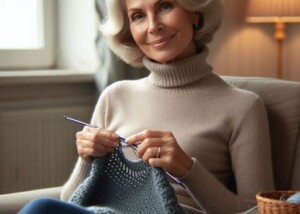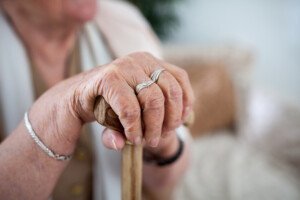
When I was a caregiver to my elderly mother, I was always easily lifting her 130-pound body off the floor.
Following quintuple bypass surgery, mitral valve replacement and a pacemaker implant, my mother developed a mysterious condition that disrupted her blood pressure and/or blood vessels (none of the doctors had an answer).
This condition caused her brain to gradually begin losing oxygen (blood flow) whenever she exited a chair (or bed) to be on her feet.
Within seconds to about two minutes, she’d begin passing out, but the passing out was gradual, rather than the sudden fainting that “drops” someone in an instant.
Because it was gradual, there was time for cognitive changes to manifest over the seconds to few minutes, stripping her of insight into what was happening.
This was combined with general non-compliance (refusing to alert me every time she exited a chair).
As a result, I couldn’t let her out of my sight or else she’d ultimately lose consciousness and fall—risking catastrophic head injury. I had to walk right behind her.
The gradual passing out was inevitable, and my mother, becoming increasingly disoriented and belligerent (from the oxygen deprivation to her brain), would eventually show signs of imminent loss of consciousness.
At this moment, I’d place my arms snug under her armpits, as I was always behind her during these incidents.
The junction of my upper and lower arms was up against her armpits. Feet about shoulder width apart, I’d then “sink” her butt to the floor (keeping my low back arched and dropping into a half squat).
At this point she was out of it, unable to contribute to the “sinking.”
Often, this bizarre malady caused her legs to stiffen, so instead of her legs bending as I “sunk” her, they remained rather straight and stiff as I placed her on her butt. If we were in crowded corners, this was tricky.
If you’re wondering why I didn’t just hold her upright till the spell passed, it’s because these slow-motion orthostatic hypotensive episodes were determined to run their course.
Had I held her upright, she would have completely lost consciousness, and I’d have to then sink her anyways. Why wait till complete loss of consciousness?
Sinking my mother to the floor had to be done gently and with control…the way a weightlifter controls the lowering of a barbell.
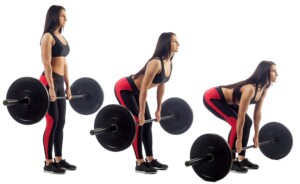
Shutterstock/Everyonephoto Studio
Once she was on the floor, she’d regain her wits, but was too weak to get up on her own. I had to lift her back up to her feet.
In case you’re wondering why I didn’t just sink her into a chair instead of the floor, this is because her mental state was too altered to respond to a directive to sit in a chair — her mental faculties were impeded.
Due to the stiff, unbending legs, getting her butt square into a chair was difficult.
I’d actually tried this initially, but had trouble aiming her butt into the nearest chair, so I decided, why not just sink her to the floor — wherever we were when one of these episodes occurred.
They occurred outdoors frequently when she got out of the car. I’d sink her on grass, cement and inside stores, then lift her back up.
As a caregiver, how did I easily lift my elderly mother from the floor?
She’d be sitting on the floor, back and head resting against my legs for some moments while the blood was restored to her brain.
But despite regaining her wits, she was too weak to get up, so I’d position my arms under her armpits and be in a position that resembled a fusion of the start of a deadlift motion (see photo above) and a half squat.
My legs and glutes powered me up, but so did my middle and lower back, though the lower back contributed only in terms of stabilizing my spine rather than force production.
I kept an arch in my lower back, making sure my back did not round, and simply straighted up, like performing a barbell “back” squat and deadlift hybrid.
Once my mother was on her feet, she could be up on them as long as she liked; the orthostatic hypotension would occur only one time after every time she rose from a seat.
I just described technique, but what about the strength to lift an elderly person from the floor without much effort?
I did this all day long and in the middle of the night, and once found myself straddling the toilet, my back facing the wall, my mother sitting on the seat in front of me, after she began passing out while on the seat (the result of exiting a chair to use the bathroom; I had followed her, anticipating the slow-motion passing out).
I never knew when I’d have to sink her and then lift her off the floor, but I was always physically prepared.
Effortless lifting of an elderly person off the floor will come to anyone who’s been training heavy with weights for a good amount of time.
Though 130 pounds doesn’t seem like much, this is entirely too heavy for most female caregivers, and even some men would struggle with this — possibly straining their back in the process and/or experiencing exhaustion.
I felt I could lift her off the floor even if she weighed 150, because my body had pre-existing training with the deadlift exercise.
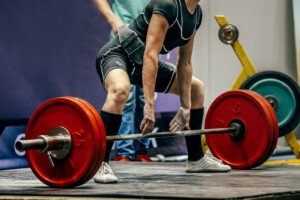
Shutterstock/sportpoint
“The sumo deadlift [above] would be THE exercise I would recommend to caregivers to be prepared for situations that would require the possibility of getting someone off of the floor,” says Dr. Chris Hardy, DO, a former Navy physician and NSCA certified strength and conditioning specialist.
“The wide stance and body mechanics of this exercise make it the most applicable and valuable for this type of situation to allow effective and safe lifting of a person from the floor.”
An alternative is the standard stance, as depicted below.
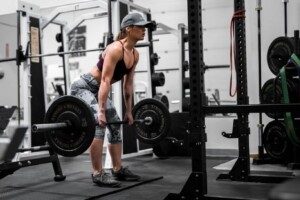
Anastase Maragos/Unsplash
If you don’t train with weights and currently are not a caregiver to an elderly mother (or father), I urge you to take up the deadlift, back squat (or dumbbell squat) and leg press — so that if one day you do become a caregiver to an elderly parent, you’ll be ready.
Go heavy and hard once you master proper form.
Additional exercises that will prepare you to lift an elderly person off the floor include the bent-over dumbbell row (shown below).
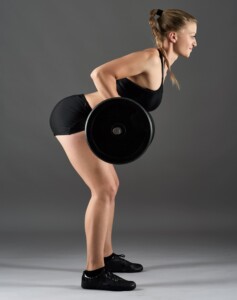
Shutterstock/Catalin Petolea
If you’re currently a caregiver to an elderly parent and don’t train with weights or have been lifting only light weights, then start lifting heavy and take up the aforementioned exercises, particularly the deadlift.

Shutterstock/The Faces
Being an lot taller than the elderly parent, whom you’re a caregiver to and trying to lift off the floor, is not a pass on training with heavy weights.
Though being taller adds a degree of biomechanical assistance — it’s pretty much worthless if your “posterior chain” muscles are out of shape (middle and lower back, butt and hamstrings).
 Dr. Hardy merges his expertise in nutrition, strength and conditioning, and in clinical/preventive medicine into a comprehensive approach to treat chronic disease.
Dr. Hardy merges his expertise in nutrition, strength and conditioning, and in clinical/preventive medicine into a comprehensive approach to treat chronic disease.
 Lorra Garrick is a former personal trainer certified through the American Council on Exercise. At Bally Total Fitness she trained women and men of all ages for fat loss, muscle building, fitness and improved health.
Lorra Garrick is a former personal trainer certified through the American Council on Exercise. At Bally Total Fitness she trained women and men of all ages for fat loss, muscle building, fitness and improved health.



